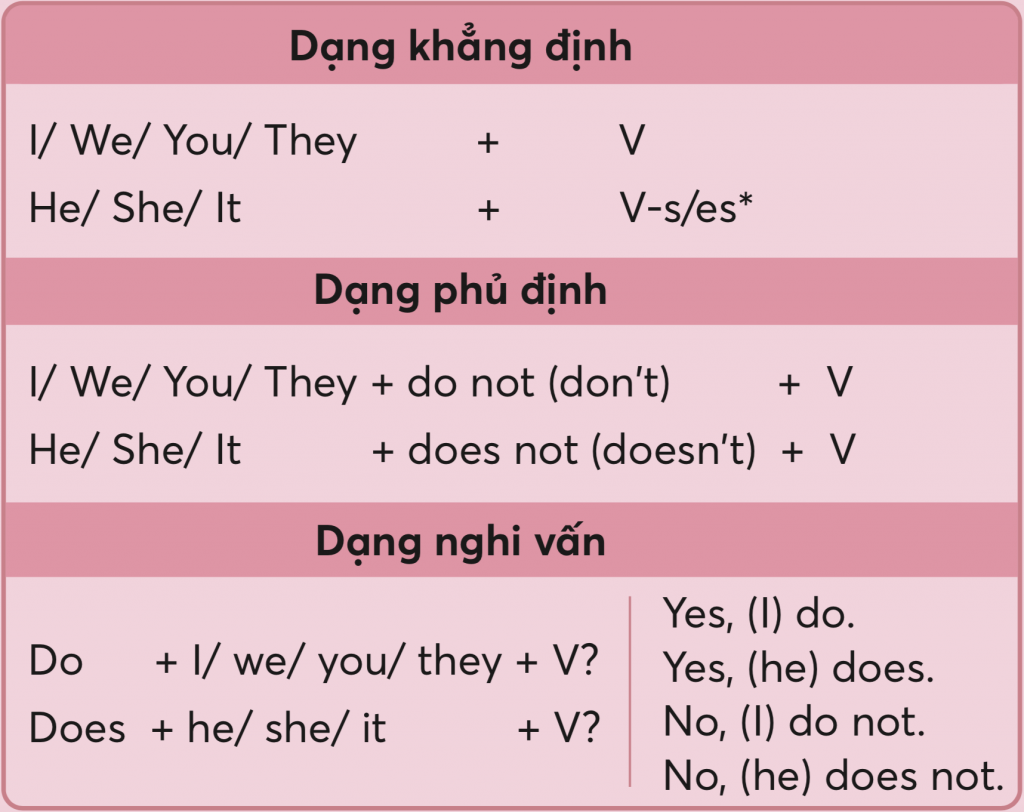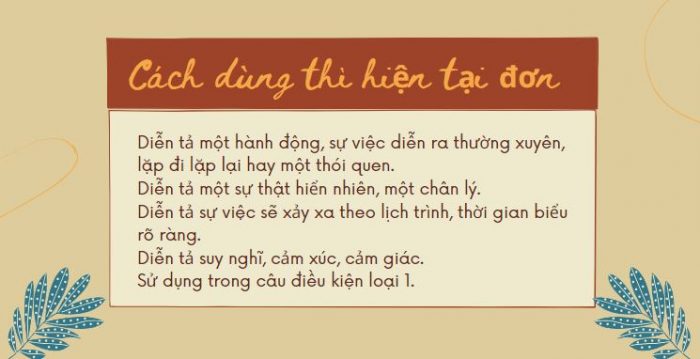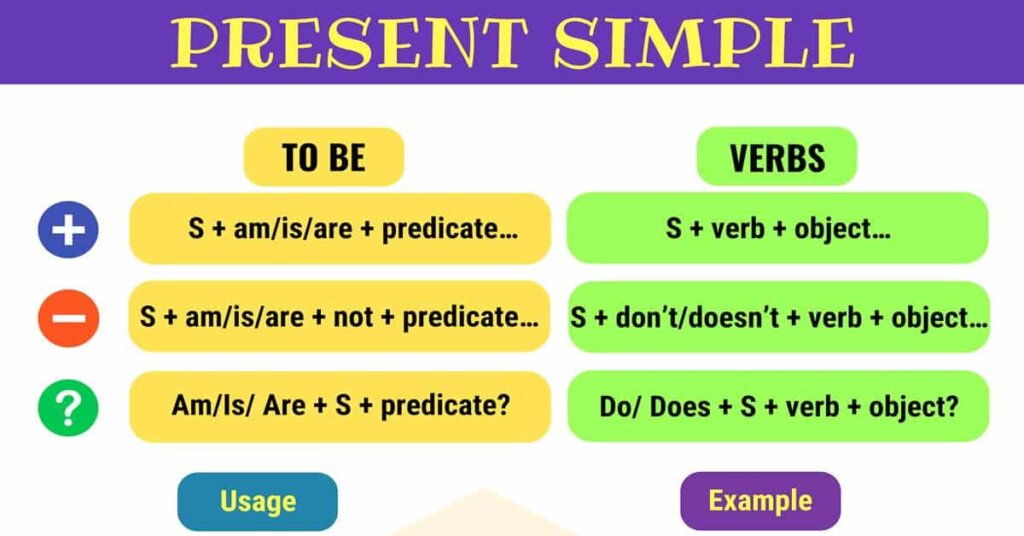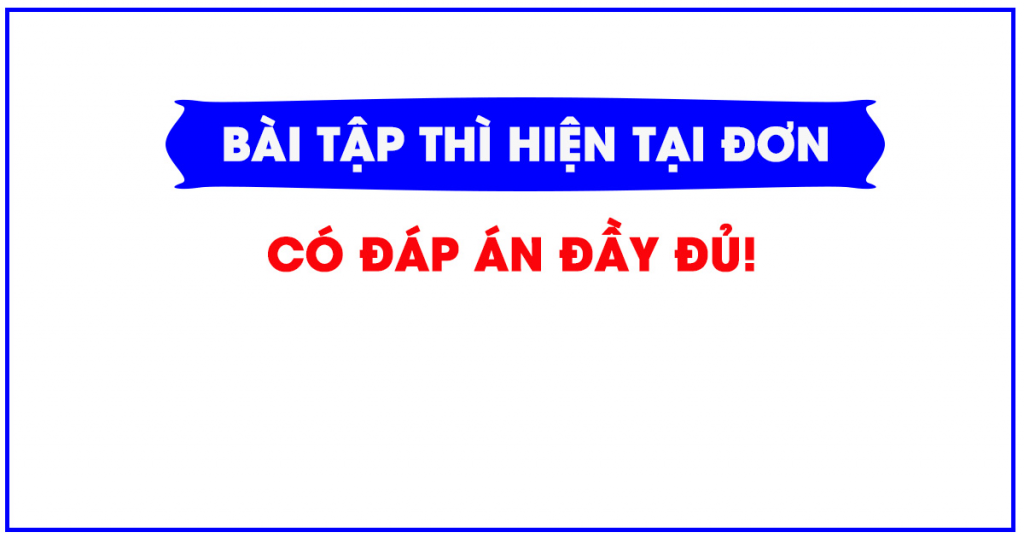Bài học hôm nay, chúng ta sẽ cùng nhau tìm hiểu về Thì Hiện tại đơn (Present Simple) và những ứng dụng của nó trong bài thi IELTS. Đây là dạng thì đơn giản nhất trong 12 thì cơ bản trong tiếng Anh nhưng là nền tảng để học các thì khác. Vì thế, các bạn cần lưu ý thực hành đầy đủ để ghi nhớ bài học này nhé!
1. Thì hiện tại đơn (Simple Present) là gì?
Thì hiện tại đơn (Simple Present hoặc Present Simple) là một trong những chủ điểm ngữ phápcơ bản. Thì hiện tại đơn diễn tả hành động hay sự việc mang tính chất chung chung, tổng quát lặp đi lặp lại nhiều lần hay một sự thật hiển nhiên hay một hành động diễn ra trong thời gian ở hiện tại.
2. Công thức thì hiện tại đơn (Simple Present)
2.1. Câu khẳng định
| ST | Động từ tobe | Động từ thường |
| Công thức | S + am/ is/ are+ N/ Adj- I + am – He/ She/ It/ Danh từ số ít/ Danh từ không đếm được + is – You/ We/ They/ Danh từ số nhiều + are | S + V(s/es) – I/ We/ You/ They/ Danh từ số nhiều + V(nguyên thể) – He/ She/ It/ Danh từ số ít/ Danh từ không đếm được + V(s/es) |
| Ví dụ | – He is a lawyer. (Ông ấy là một luật sư) – The watch is expensive. (Chiếc đồng hồ rất đắt tiền) – They are students. (Họ là sinh viên) | – I often go to school by bus (Tôi thỉnh thoảng đến trường bằng xe buýt) – He usually gets up early. (Anh ấy thường xuyên dạy sớm) – She does homework every evening. (Cô ấy làm bài về nhà mỗi tối) – The Sun sets in the West. (Mặt trời lặn ở hướng Tây) |
- Với các từ có tận cùng là: “o”, “ch”, “sh”, “x”, “s” “z” thì khi sử dụng với ngôi số ít, thêm đuôi “es” vào. Ví dụ minh hoạ: go – goes; do – does; watch – watches; fix – fixes, miss – misses, wash – washes.

- Với các từ có tận cùng là: “y” thì khi sử dụng với ngôi số ít, bỏ “y” và thêm đuôi “ies”. Ví dụ minh hoạ: copy – copies; study – studies
- Với các từ còn lại, thêm đuôi “s” vào. Ví dụ minh hoạ: see – sees; play – plays,…
2.2. Câu phủ định
| Động từ “to be” | Động từ chỉ hành động | |
| Công thức | S + am/are/is + not +N/ Adj | S + do/ does + not + V(nguyên thể) (Trong đó: “do”, “does” là trợ động từ.) |
| Chú ý (Viết tắt) | is not = isn’t are not = aren’t | do not = don’t does not = doesn’t |
| Ví dụ | – I am not a teacher. (Tôi không phải là một giáo viên.) – He is not (isn’t) a lawyer. (Ông ấy không phải là một luật sư) – The watch is not (isn’t) expensive. (Chiếc đồng hồ không đắt tiền) – They are not (aren’t) students. (Họ không phải là sinh viên) | – I do not (don’t) often go to school by bus (Tôi không thường xuyên đến trường bằng xe buýt) – He does not (doesn’t) usually get up early. (Anh ấy không thường xuyên dạy sớm) – She does not (doesn’t) do homework every evening. (Cô ấy không làm bài về nhà mỗi tối) – The Sun does not (doesn’t) set in the South. (Mặt trời không lặn ở hướng Nam) |
Đối với câu phủ định, phần động từ thường, các bạn rất hay mắc lỗi khi thêm “s” hay “es” đằng sau động từ. Các bạn cần lưu ý:
| Chủ ngữ + don’t/ doesn’t (trợ động từ) + V (nguyên thể – không chia) |
Ví dụ minh hoạ:
Câu sai: She doesn’t likes chocolate. (Sai bởi vì đã có “doesn’t” mà động từ “like” vẫn có đuôi “s”)
=> Câu đúng sẽ là: She doesn’t like chocolate.
2.3. Câu nghi vấn
a. Câu nghi vấn sử dụng trợ động từ (Câu hỏi Yes/ No)
| Động từ to “be” | Động từ chỉ hành động | |
| Công thức | Câu hỏi: Am/ Are/ Is (not) + S + N/Adj? Câu trả lời: – Yes, S + am/ are/ is. – No, S + am not/ aren’t/ isn’t. | Câu hỏi: Do/ Does (not) + S + V (nguyên thể)? Câu trả lời: – Yes, S + do/ does. – No, S + don’t/ doesn’t. |
| Ví dụ | Câu hỏi: Are you an engineer? (Bạn có phải là kỹ sư không? Câu trả lời: Yes, I am. (Đúng vậy) No, I am not. (Không phải) | Câu hỏi: Does she go to work by taxi? (Cô ấy đi làm bằng taxi phải không?) Câu trả lời Yes, she does. (Có) No, she doesn’t. (Không) |
b. Câu nghi vấn sử dụng từ hỏi bắt đầu bằng Wh-
| Động từ to “be” | Động từ chỉ hành động | |
| Công thức | Wh- + am/ are/ is (not) + S + N/Adj? | Wh- + do/ does (not) + S + V (nguyên thể)….? |
| Ví dụ | – Where are you from? (Bạn đến từ đâu?) – Who are they? (Họ là ai?) | – Where do you come from? (Bạn đến từ đâu?) – What do you do? (Bạn làm nghề gì?) |
3. Dấu hiệu nhận biết thì hiện tại đơn
3.1. Khi trong câu xuất hiện các trạng từ chỉ tần suất
- Always, usually, often, sometimes, frequently, seldom, rarely, hardly, never, generally, regularly,….
- Every day, week, month, year,…
- Once, twice, three times, four times….. a day, week, month, year,…
3.2. Vị trí của các trạng từ chỉ tần suất trong câu thì hiện tại đơn.
Các trạng từ này thường đứng trước động từ thường, đứng sau động từ tobe và các trợ động từ như: Always, usually, often, sometimes, rarely, seldom, …
4. Cách dùng thì hiện tại đơn (Simple Present) trong trường hợp thường

Thì hiện tại đơn (Simple Present) được sử dụng để:
- Nói về một thói quen lặp đi lặp lại mỗi ngày. Ví dụ: I alway get up at 6.am
- Nói về một sự thật, chân lý hiển nhiên. Ví dụ: The sun sets in the west
- Nói về khả năng của một ai đó. Ví dụ: She plays basketball very well
- Nói về lịch trình định sẵn thường xuyên, quy trình. Ví dụ: This train goes to Milan at 9a.m tomorrow.
Trong cách dùng thì hiện tại đơn thường xuất hiện các trạng từ chỉ tần suất cơ bản: always, usually, often, sometimes, rarely, everyday, once a month, in the morning, once in a blue moon…
5. Một số cụm từ thay thế hay để sử dụng trong bài thi IELTS
Tuy nhiên, những từ/ cụm từ trên khá phổ biến và nhàm chán, khi đưa vào câu trong bài thi IELTS cũng chỉ sử dụng 1 cấu trúc S + adverb + verb, khiến cho các bạn thí sinh không thể hiện được sự đa dạng về ngữ pháp. Nên hãy tham khảo thêm các cụm từ thay thế dưới đây.
Để đa dạng ngữ pháp, duhoctms.edu.vn khuyên các bạn:
- KHÔNG CẦN sử dụng liên tục.
- Tìm các câu thành ngữ, các cách nói hay hơn. Dưới đây là một số cụm từ dễ dàng “ghi điểm” mà các bạn có thể tham khảo.
| Cụm từ | Ví dụ |
| (to) have one’s moments = sometimes | I am not usually lazy, but I have my moments. |
| (every) now and then/again= sometimes | I have to cut down on my sugar intake, but every now and then I indulge myself with some quality dark chocolate. |
| like clockwork= always | My father walks the dog every morning like clockwork. |
6. Cách sử dụng của thì hiện tại đơn trong bài thi IELTS
6.1. Mở đầu Speaking part 1/2/3 và Writing task 1/2
Ví dụ minh hoạ:
- I am a third-year student in Internal Auditing.
(Tôi đang là sinh viên năm thứ ba học ngành Kiểm toán nội bộ) (Mở đầu – Speaking part 1)
- Well, my most favorite item of clothing is the yellow crop-top.
(Món đồ tôi thích nhất là chiếc áo crop-top màu vàng) (Mở đầu – Speaking part 2 – “Describe your most favorite item of clothing” – Mô tả món đồ mà bạn yêu thích nhất)
- I think students should go to universities rather than vocational training courses.
(Tôi nghĩ rằng sinh viên nên học đại học hơn là học nghề) (Mở đầu – Speaking part 3)
6.2. Mô tả sự thật trong Speaking part 1/2/3
Ví dụ minh hoạ:
- Advertisements are very relaxing and eye-catching.
(Quảng cáo rất mang tính giải trí và bắt mắt) (Sự thật)

- Lady Gaga is famous all over the world.
(Lady Gaga nổi tiếng trên toàn thế giới) (Sự thật)
Ngoài thì hiện tại đơn, các bạn cũng cần học đầy đủ các thì khác trong tiếng Anh để củng cố thêm kiến thức nền tảng của mình.
7. Bài tập thì thì hiện tại đơn (Simple Present)
Phần bài tập
Exercise 1: Cho dạng đúng của động từ trong mỗi câu sau
1. My mom always …………………………..delicious meals. (make)
2. Charlie…………………………..eggs. (not eat)
3. Susie………………………….shopping every week. (go)
4. ………………………….. Minh and Hoa ………………………….. to work by bus every day? (go)
5. ………………………….. your parents …………………………..with your decision? (agree)
6. Where……………………..he………………………from? (come)
7. Where ………………………….. your father …………………………..? (work)
8. Jimmy …………………………… usually ………………………….. the trees. (not water)
9. Who …………………………..the washing in your house? (do)
10. They ………………………….. out once a month. (eat)
Exercise 2: Mỗi câu sau chứa MỘT lỗi sai. Tìm và sửa chúng.
1. I often gets up early to catch the bus to go to work.
………………………………………………………………………
2. She teach students in a local secondary school.
………………………………………………………………………
3. They doesn’t own a house. They still have to rent one to live.
………………………………………………………………………
4. Bui Tien Dung am a famous goalkeeper in the National Football Team.
………………………………………………………………………
5. What do your sister do?
………………………………………………………………………
6. John and Harry doesn’t go swimming in the lake.
………………………………………………………………………
7. Liam speak Chinese very well.
………………………………………………………………………
8. How often does she goes shopping in the supermarket?
………………………………………………………………………
9. Our dogs aren’t eat bones.
………………………………………………………………………
10. Claire’s parents is very friendly and helpful.
………………………………………………………………………
Exercise 3: Chia những động từ sau ở thì hiện tại đơn để tạo thành một bài IELTS Writing task 1 có nghĩa.
” The diagram below shows the stages and equipment used in the cement-making process, and how cement is used to produce concrete for building purposes.
Summarize the information by selecting and reporting the main features and make comparisons where relevant.
Write at least 150 words.
The diagrams (1 – illustrate)…………………………….the way in which cement is made and how it is then used in the process of making concrete. Overall, limestone and clay (2-pass)……………………… through four stages before being bagged ready for use as cement which then (3-account) for 15% of the four materials used to produce concrete. While the process of making cement (4-use)………………………..a number of tools, the production of concrete (4-require) only a concrete mixer.
In the first stage of making cement, limestone and clay (5-be)……………..crushed together to form a powder. This powder (6-be)………………then combined in a mixer before passing into a rotating heater which (7-have)………………… constant heat applied at one end of the tube. The resulting mixture is ground in order to produce cement. The final product is afterwards put into bags ready to be used.
Regarding the second diagram, concrete (8-consist)………………………of mainly gravel, which is small stones, and this makes up 50% of the ingredients. The other materials used are sand (25%), cement (15%) and water (10%). These are all poured into a concrete mixer which continually rotates to combine the materials and ultimately produces concrete.”
(187 words, Band 9.0)
Exercise 4: Trả lời những câu hỏi sau sử dụng những trạng từ tần suất ở phần lý thuyết.
1. How often do you buy a new item of clothing?
…………………………………………………………………….
2. When do you often eat breakfast in the morning?
…………………………………………………………………….
3. What do you do?
…………………………………………………………………….
4. Do you have a pet?
…………………………………………………………………….
5. Are you afraid of spiders?
…………………………………………………………………….
Exercise 5: Cho dạng đúng của những từ trong ngoặc để tạo thành câu có nghĩa.
1. It (be)………………a fact that smart phone (help)………………..us a lot in our life.
2. I often (travel)………………..to some of my favorite destinations every summer.
3. Our Math lesson usually (finish)…………………….at 4.00 p.m.
4. The reason why Susan (not eat)……………………….meat is that she (be)…………a vegetarian.
5. People in Ho Chi Minh City (be)………..very friendly and they (smile)………………a lot.
6. The flight (start)………………..at 6 a.m every Thursday.
7. Peter (not study)…………………………very hard. He never gets high scores.
8. I like oranges and she (like)……………..apples.
9. My mom and my sister (cook)…………………….lunch everyday.
10. They (have)…………………breakfast together every morning.
Exercise 6: Chia động từ trong ngoặc ở thì Hiện Tại Đơn
1. I (be) ________ at school at the weekend.
2. She (not study) ________ on Friday.
3. My students (be not) ________ hard working.
4. He (have) ________ a new haircut today.
5. I usually (have) ________ breakfast at 7.00.
6. She (live) ________ in a house?
7. Where your children (be) ________?
8. My sister (work) ________ in a bank.
9. Dog (like) ________ meat.
10. She (live)________ in Florida.
11. It (rain)________ almost every day in Manchester.
12. We (fly)________ to Spain every summer.
13. My mother (fry)________ eggs for breakfast every morning.

14. The bank (close)________ at four o`clock.
15. John (try)________ hard in class, but I (not think) ________ he`ll pass.
16. Jo is so smart that she (pass)________ every exam without even trying.
17. My life (be) so boring. I just (watch)________ TV every night.
18. My best friend (write)________ to me every week.
19. You (speak) ________ English?
20. She (not live) ________ in HaiPhong city.
Exercise 7: Viết lại câu hoàn chỉnh
Ví dụ: They/ wear suits to work? => Do they wear suits to work?
- she/ not/ sleep late at the weekends =>________
- we/ not/ believe the Prime Minister =>________
- you/ understand the question? =>________
- they/ not/ work late on Fridays =>________
- David/ want some coffee? =>________
- she/ have three daughters =>________
- when/ she / go to her Chinese class? =>________
- why/ I/ have to clean up? =>_______
Exercise 8: Hoàn thành đoạn hội thoại sau:
Rita: (►) Do you like (you/ like) football, Tom?
Tom: (►) / love (1 / love) it. I`m a United fan. (1)……………………………… (I/ go) to all their games. Nick usually (2) …………………………………………. (come) with me. And (3) ……………………………………….. (we/ travel) to away games, too. Why (4) ……………………………………… (you/ not/ come) to a match some time?
Rita: I`m afraid football (5)………………………………….. (not/ make) sense to me — men running after a ball. Why (6) ……………………………………………… (you/ take) it so seriously?
Tom: It’s a wonderful game. (7) ………………………………………… (I/ love) it. United are my whole life.
Rita: How much (8)………………………………….. (it/ cost) to buy the tickets and pay for the travel?
Tom: A lot. (9) ……………………….. (I/ not/ know) exactly how much. But (10) (that/ not/ matter) to me. (11) ………………………. (I/ not/ want) to do anything else. (12) …………………….. (that/ annoy) you?
Rita: No, (13) …………………….. (it/ not/ annoy) me. I just (14) (find) it a bit sad.
Phần đáp án
Exercise 1
| 1. makes 2. doesn’t eat 3. goes 4. do…go 5. Do…agree | 6. does…come 7. does…work 8. doesn’t usually water 9. does 10. eat |
Exercise 2
| 1. gets => get 2. teach => teaches 3. doesn’t => don’t 4. am => is 5. do your => does your | 6. doesn’t => don’t 7. speak => speaks 8. goes => go 9. aren’t => don’t 10. is => are |
Exercise 3
| 1. illustrate 2. pass 3. accounts 4. uses-requires | 5. are 6. is 7. has 8. consists |
Exercise 4
Tùy vào kinh nghiệm cá nhân của các bạn
Exercise 5
| 1. is, helps 2. travel 3. finishes 4. doesn’t eat, is 5. are, smile | 6. starts 7. doesn’t study 8. likes 9. cook 10. have |
Exercise 6
1 – am
2 – does not study
3 – are not
4 – has
5 – have
6 – lives
7 – Where are your children?
8 – works
9 – likes
10 – lives
11 – rains
12 – fly
13 – flies
14 – closes
15 – tries – do not think
16 – passes
17 – is – watch
18 – writes
19 – Do you speak English?
20 – does not live
Exercise 7
1. She doesn’t sleep late at the weekends.
2. We don’t believe the Prime Minister.
3. Do you understand the question?
4. They don’t work late on Fridays.
5. Does David want some coffee?
6. She has three daughters.
7. When does she go to her Chinese class?
8. Why do I have to clean up?
Exercise 8
1. I go
2. comes
3. we travel
4. don’t you come
5. doesn’t make
6. do you take
7. I love
8. does it cost
9. I don’t know
10. that doesn’t matter
11. I don’t want
`12. Does that annoy
13. it doesn’t annoy
14. find
Trên đây là toàn bộ kiến thức về thì thì hiện tại đơn (Simple Present) trong tiếng Anh cũng như các bài tập thực hanh. Cùng theo dõi những bài viết tiếp theo của duhoctms.edu.vn để học thêm nhiều chủ điểm ngữ pháp nữa nhé!

Bình luận